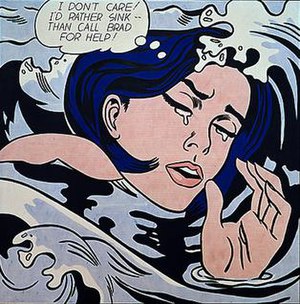| Drowning Girl | |
|---|---|
 | |
| Artist | Roy Lichtenstein |
| Year | 1963 |
| Catalogue | 80249 |
| Medium | oil and synthetic polymer paint on canvas |
| Dimensions | 171.6 cm × 169.5 cm (67+5⁄8 in × 66+3⁄4 in) |
| Location | Museum of Modern Art, New York City |
| Accession | 685.1971 |
Drowning Girl (also known as Secret Hearts or I Don't Care! I'd Rather Sink) is a 1963 American painting in oil and synthetic polymer paint on canvas by Roy Lichtenstein, based on original art by Tony Abruzzo. The painting is considered among Lichtenstein's most significant works, perhaps on a par with his acclaimed 1963 diptych Whaam!. One of the most representative paintings of the pop art movement, Drowning Girl was acquired by the Museum of Modern Art in 1971.
The painting has been described as a "masterpiece of melodrama", and is one of the artist's earliest images depicting women in tragic situations, a theme to which he often returned in the mid-1960s. It shows a teary-eyed woman on a turbulent sea. She is emotionally distressed, seemingly from a romance. Using the conventions of comic book art, a thought bubble reads: "I Don't Care! I'd Rather Sink — Than Call Brad For Help!" This narrative element highlights the clichéd melodrama, while its graphics — including Ben-Day dots that echo the effect of the printing process — reiterate Lichtenstein's theme of painterly work that imitates mechanized reproduction. The work is derived from a 1962 DC Comics panel; both the graphical and narrative elements of the work are cropped from the source image. It also borrows from Hokusai's The Great Wave off Kanagawa and from elements of modernist artists Jean Arp and Joan Miró. It is one of several Lichtenstein works that mention a character named Brad who is absent from the picture.